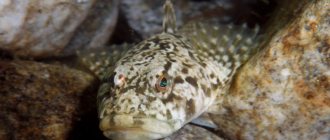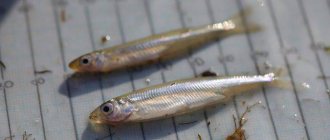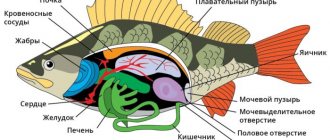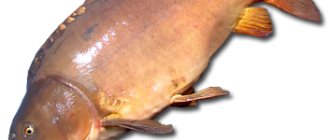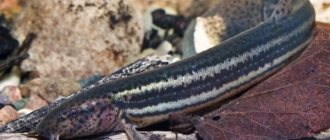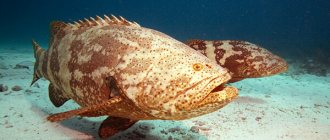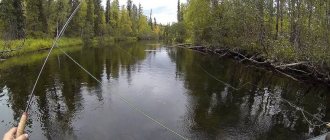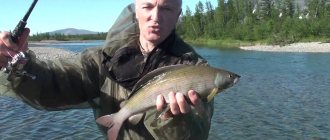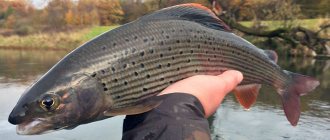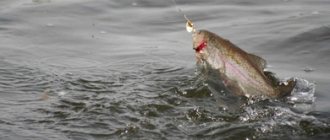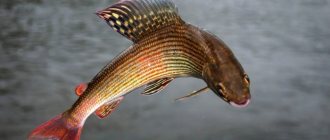Description
The color of the black individual is predominantly dark olive, sometimes with shades of blue or large spots of red. The fins on the chest are yellow or olive in color, on the abdominal cavity - yellow shades with red stripes along the body. The fin near the anal area has a mixed shade of red and purple, there are stripes of blue with a wavy shape. The fins near the tail and fatty part are crimson in color.
The base of the belly begins a red or brick-colored stripe that extends to the end of the fin on the back. Has a longitudinal shape. There are also green, purple or red spots in the color palette. On the extreme part of the upper fin.
Common grayling
This subspecies is also known as European grayling. The name is certainly associated with its distribution area, which covers European countries, not only mainland France and Germany, but also island countries - Great Britain and the Scandinavian countries. In Russia, it can be found in almost all rivers up to the Urals; there is no such fish only in the basins of the Don and Dnieper rivers, as well as in the Crimea and Kuban. Despite its love for fast-flowing rivers, grayling is also found in European lakes, for example, in Lake Ladoga and Onega. There it stays until the start of the spawning period. It goes into the rivers to spawn.
In the northern waters of Russia, grayling is present in large numbers here and there, and fishermen certainly take advantage of this. But in the Yaroslavl, Chelyabinsk, and Moscow regions, the number of European grayling is extremely small, so the catch of this fish is strictly regulated. The Russian Red Book lists this species as endangered, so fishermen who accidentally catch an individual are required to release it. Again, the law does not apply to all regions, but only to the Moscow region, Yaroslavl, Chelyabinsk and their environs. In other parts of the country you can catch this fish safely. And if you are interested in this topic, then here you can find out what gear is needed for this.
The common grayling has a small lower and upper jaw
In order not to break the law, even by accident, any fisherman must know what this fish looks like, because ignorance of the rules does not exempt you from responsibility. By the way, you can pay for inattention on a fairly large scale. According to official data, today illegal fishing of European grayling is punishable by a fine of 1,500 to 2,000 rubles, and the gear used to catch the fish is also confiscated. This amount also includes the penalty for the caught fish itself - about 500 rubles per piece.
So, what does this “expensive” fish look like, the capture of which can hit your wallet hard? First, look at the photo of grayling.
In certain lighting, the fins of a fish can shimmer, making it invisible in a mountain river with a large current.
A high crest is a distinctive feature of all subspecies of the grayling family. It helps the fish stay in the current.
As you can see, the European grayling is characterized by the fact that it has a small upper jaw, which makes the entire mouth of the fish look small. The mouth is armed with small teeth, they are weak and almost invisible, since they look more like bristles.
Fishing for Siberian grayling
Grayling fishing is an exciting activity. In the European part of Russia, this fish is most often caught on a spinning rod using small spoons.
The body has an elongated, slanted shape, thanks to which the fish moves freely both with and against the current. This subspecies is characterized by the following maximum length-to-weight ratio: 50 cm and 1.5 kg.
The calling card of grayling is its color. Firstly, it has very large scales compared to other fish of similar size. Up to 93 scales can be counted along the lateral line. Along the back they give the fish a greenish color, on the sides they merge into a tin-silver surface, and the belly makes it silver-white. Young grayling fish are distinguished by the presence of oval-shaped spots on the sides; with age they merge with the main color of the fish.
Ice fishing for grayling is common in many regions.
The main fin of grayling consists of 13 or more branched rays, plus about 5-7 unbranched ones. They form a real “sail”, which distinguishes this fish from other representatives of the underwater kingdom. Often the fins, which are located in the area of the chest and abdomen, are gray-yellow in color. In older individuals, the pectoral and pelvic fins may have a reddish tint. The tail, anal fin and dorsal sail have a purple tint. Very effective.
During the period when grayling reaches sexual maturity, the color becomes even brighter and more attractive. Biologists believe that mimicry is the main language of fish, with which females express their readiness to reproduce. In males, during the mating season, in addition to color, the height of the dorsal fin also changes. It stretches even more in length, and becomes larger and tougher.
The Baikal subspecies has a pronounced dark color. This is due to the deep lifestyle characteristic of this subspecies
Nutrition
The main food of black Baikal grayling consists of amphipods (Amphipoda); in second place are the larvae of caddisflies (Trichoptera), then various insects (beetles, hymenoptera). Fish and shellfish play a minor role in nutrition.
During the spawning period, the black Baikal grayling eats the eggs of sculpin, lenok, and grayling. The main food of white Baikal grayling consists of fish, mainly sculpins and Baikal broadheads (Cottidae and Cottocomephoridae) and crustaceans (Amphipoda), aerial insects and mollusks are of secondary importance.
Appearance and morphology
The number of gill rays is from 9 to 12 (average 10.35), gill rakers - from 15 to 20 (average 17.1). The number of scales in the midline is from 86 to 106, the number of vertebrae is from 59 to 62 (on average 61.16); the number of pyloric signs is from 14 to 24 (average 18, 32). The dorsal fin is low. Its height in the anterior part ranges from 8.5 to 15.5%, in the posterior part - from 4.5 to 9.5% of the body length. The length and height of the dorsal fin of the grayling differs from all other representatives of Thymallus.
The anal fin makes up from 6.5 to 10.5% of the body length, the short and caudal peduncle - from 14.0 to 18% of the same length. The length of the upper jaw is only 5.52% of the length of the body, or 32.39% of the length of the head. The width of this jaw is on average equal to 2.31% of the body length, or 9.96% of the head length. The color of the head is light grayish on top. The bones of the preoperculum, operculum and periorbital ring are silvery. The iris of the eyes is greenish-golden.
The color of the body on the sides of the body is silvery, and on the back it is the same light grayish as the color of the head. Sometimes there are sparse rounded black spots on the sides of the body in the front part. The ventral and pectoral fins are dark yellow. On the gray background of the dorsal fin, especially in its posterior part, there are 3–4 horizontal rows of dark red oval or quadrangular spots. There is a faint dark red border along the upper edge of the dorsal fin. During the spawning period, mature fish appear in brighter colors.
The fins become colorful, the sides of the body remain silver, but acquire a light metallic tint; above the pelvic and anal fins there are barely noticeable copper-red spots. The nuptial plumage is more pronounced in fish that spawn again; in fish that spawn for the first time, it is dimly colored on the body and fins. The question of the taxonomic status of white grayling has not been fully resolved.
Migration
Grayling prefers to stay in one place, occasionally moving along the coastline. It gathers in schools at a depth of no more than 25 meters, often near small rivers of the Baikal basin.
Loves the rocky surface of not only the bottom, but also the shore. It is desirable that they be covered with thickets, with a large number of amphipods, larvae, etc.
It prefers to live at a temperature of about 12 degrees, and during hot summer periods it descends to depth. With the onset of spring, adult individuals of the black subspecies accumulate near the rivers of Baikal in order to go out to spawn in May. Schools arrive at the mouth of the Angara 30 days before breeding begins, around the beginning of March.
At the beginning of summer, white Baikal grayling gathers in large flocks to move along the coastline. In summer, it prefers to stick to the bottom layers of the water.
It often lives on a sandy bottom, at a depth of 30 to 40 meters, with temperatures up to 10 degrees. In winter, it prefers to rise to 30 meters. In terms of fishing, it lives only in the center or north of Lake Baikal.
Baikal white grayling
Thymallus arcticus baicalensis infrasubspecies brevipinnis
Order Salmoniformes - Salmoniformes
Grayling family - Thymallidae
STATUS. Small species (II category)
Habitat
One of the forms of Baikal grayling, sharply reducing its numbers.
Spreading. Lake Baikal (mainly the eastern coast) and the rivers flowing into it (1 - 3).
Number. Not studied. In catches it is usually taken into account together with black Baikal grayling. In the 20s The annual catch of grayling in Baikal reached 100 - 140 tons (2). In recent years, fishing has been largely uncontrolled and amateur in nature.
Ecology. Lake and river fish. Reaches a length of 48 cm and a weight of 1 - 2 kg. Males are on average larger than females. In Baikal, grayling is found in the coastal zone at a depth of 25 - 30 m (3). Becomes sexually mature at the age of 6 - 7 years. It breeds in rivers, mainly in the Selenga and its tributaries - Dzhida, Khilok, Chikoy (3). Spawning migration begins in the first half of August and continues throughout the winter. The spring movement of grayling into rivers has also been noted (3). Grayling rises hundreds of kilometers. Spawning takes place on pebble-sand shallows and rifts from late April to mid-May at water temperatures from 7.5 to 14.6 degrees C. Breeders have a bright breeding plumage, especially males: the body is dark gray with a metallic tint, copper-red spots above the ventral fins and behind the anal fin; the same spots are on the dorsal fin, and a dark red border stretches along its upper edge. The eggs develop in about 17 days.
Fertility - from 5.5 to 28.4 thousand eggs, on average about 12 thousand. After spawning, some of the fish die, and the bulk rolls into Baikal, where they are intensively fattened. It feeds on gammarids, caddisfly larvae, mollusks, flying insects, and small fish. White grayling grows faster than black grayling, is larger and is more of a predator (1 - 3). Life expectancy, apparently, does not exceed 10 - 12 years (3).
Limiting factors. Intensive fishing in spawning rivers, pollution of water bodies, deterioration of breeding conditions.
Security measures. Establish a complete ban on the fishing of white grayling, paying special attention to the protection and reclamation of spawning grounds. Expand work on its artificial breeding.
Bibliography
1. Svetovidov, 1931;
2. Svetovidov, 1936;
3. Tugarina, 19
Information about the work “Baikal white grayling”
Section: Biology and Chemistry Number of characters with spaces: 2301 Number of tables: 0 Number of images: 1
Similar works
Biological analysis of Siberian grayling from Lake Chitkanda
28133
4
0
... white, live in the lake itself. Baikal and the waters of its basin. 3.1 Nutrition and growth of grayling o. Chitkanda The concentration, availability of food and its quality, as well as water temperature are of decisive importance for the development and growth of juvenile grayling in Lake Chitkanda at the larval and fry stages. Depending on the water temperature, the larval stage of grayling ends at 25 days of age, with a length of 22-25 mm, ...
Organization of reception of foreign tourists in the Baikal region
163079
18
1
...is there demand for travel in the Baikal region in the period from November to April. One of the marketing tools for determining demand is questionnaires. At the end of their trip to the Baikal region, foreign tourists answered questions from a specially designed questionnaire. The following results were obtained from the survey. Table No. 12 Students Pensioners Working Have you been...
Modeling environmental problems and ways to solve them in chemistry lessons
16479
0
5
... dynamic scheme 1 is the ability to act in reverse order. Having examined in class how to prevent acid emissions from entering the atmosphere and eliminating the consequences of their impact on nature, you can use dynamic diagram 1 to show how the environmental situation is improving. This dynamic visualization technique improves...
Taxes and payments for the use of natural resources
50747
14
0
...and a hot topic. It can be assumed that bills will be finalized and further developed, and perhaps the introduction of some innovations and tougher measures against violators of the regime for the use of natural resources and their inappropriate use. And because of this, a number of reasons can be identified, based on which we can draw a conclusion about the trends in the development of payments for natural resources. ...
Spawning
Grayling leaves for spawning around May-June. The fish becomes sexually mature at 3-4 years of age. To lay eggs, it remains in shallow riffles if the rivers are large, or rises into tributaries (streams, rivulets). The soil required is pebble-sand.
It is interesting that after spawning, the females are the first to leave the spawning grounds, and the males take care of the offspring. It is expressed in sprinkling part of the eggs with sand to prevent other inhabitants of the reservoir from eating the eggs.
The fry hatches within 25-30 days. It all depends on the water temperature. After birth, the grayling fry remains in the place of birth. Here he grows up and eats himself off. Closer to winter, it begins to migrate into rivers for the winter. Grayling does not make long migrations, even spawning ones. All his long movements can be within 20-40 km.
